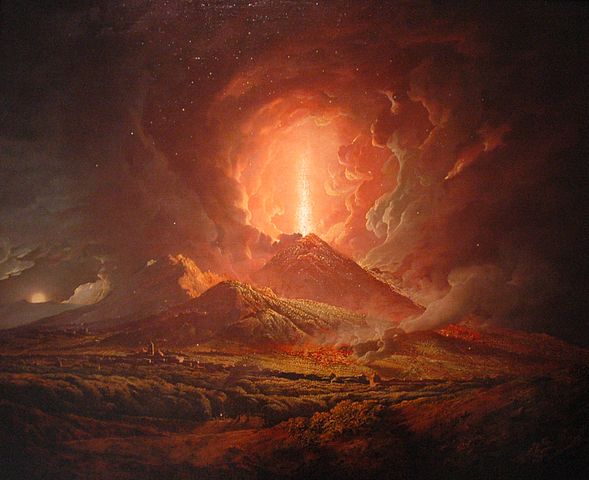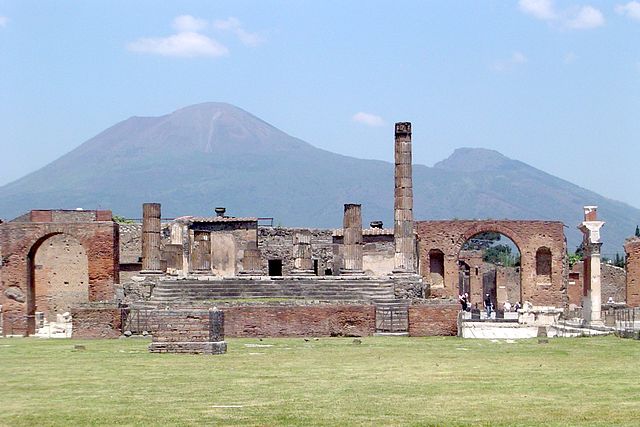[This has been revised from previous version adding new information, correcting grammar and punctuation, and new source information.]

Image:Public Domain
It was just around noon on 24 August 79 AD when Mount Vesuvius erupted with a massive 10-mile mushroom cloud sent into the stratosphere. It would become one of the deadliest volcanic eruptions in history. Ash and pumice would rain down over the entire area for twelve hours. Those who fled early on were able to survive what came next. A pyroclastic flow-a fast moving of hot gas mixed with volcanic matter-would sweep down from the mountain engulfing the area and killing everyone still there. The eruption was so massive and so powerful that geologists use the term Vesuvian to describe similar deadly eruptions of its kind.
The Bay of Naples was during this period of time known for its trade and luxury. Foods and other commodities were constantly being shipped in and out allowing the cities of Pompeii and Herculaneum to have a high standard of living. The resort city of Stabiae was the place many went to relax in. Mount Vesuvius stood majestically above it all and no one considered the mountain could one day be a problem. There were no records of any eruptions during Roman history. There was an eruption during the Bronze Age that decimated settlements and even more violent eruptions in the far past. During the Roman period and the prior periods when the Greeks and others had settled in the areas, there were no eruptions. Stromboli was known to them and had been actively erupting long before the Romans. Stromboli erupts near its crater and, in most cases, causes no damage. So, Romans had no experience with volcanic eruptions like what happened in 79 AD.
There had been earthquakes that had occurred prior to the eruption. Excavations have determined they were in the process of repairing streets and underground plumbing damaged by them. However, they had no idea the tremors related to the nearby mountain. Indeed, they were caught by surprise when around 1 pm on 23 August when Vesuvius began erupting and spewing forth hot ash and pumice which began to rain down on the area. People close to the volcano began to flee and others, nervous about the situation, did as well. It is estimated about 20,000 people lived in both Pompeii and Herculaneum. As the hours went on, people could see what looked like fires on the mountain causing many more to likely flee. Pyroclastic flows started coming down near the mountain and then later consume settlements near them. The flows took down everything in their paths and killed everyone that was there. Ash and pumice continued to fall adding more problems for breathing and started damaging structures. Other earthquakes added damage and there was a minor tsunami in the Bay of Naples.
It was on the second day that Vesuvius would erupt so massively that it would give the name to such violent eruptions. The massive 10-mile mushroom cloud released 1,000 times more than the nuclear devices used on Hiroshima and Nagasaki in 1945. The massive amounts of ash and pumice ejected was about 1.5 million tons per second. The pyroclastic flows it generated on the second day swept through Pompeii, Herculaneum, Oplontis, and Stabiae killing anyone who had not fled with the ash and pumice burying them completely. The only surviving account as to what happened comes from the writings of Pliny the Younger who witnessed the eruption while staying west across the Bay of Naples. His uncle, Pliny the Elder, sailed over to Stabiae to find out what was going on. They had planned to stay the night, but the ash and pumice had made the houses unstable and decided to leave. Unfortunately, a plume of toxic gases came over the area and they had to flee. Pliny though was unable to escape and would die. They would find his body three days later exactly where he fell with no other injuries. Pliny the Younger would compile survivor accounts and his own observations. He provided them to Tacitus, who included it his writings.
The reaction of the Roman people was utter disbelief. No one had any inkling that Mount Vesuvius was deadly. And at least 20,000 people were believed dead. Many wealthy Romans and senators had residences there. It was a major loss for the Romans. Rome declared a mourning period, though its exact length is unknown but perhaps up to a year. Depictions from that time show Romans wearing dark robes to signify the mourning. The new Emperor Titus sent two consuls to Pompeii the set up any assistance that was needed. He ordered the treasury to aid the Compania region and rebuild Pompeii. Property was given to survivors whose relatives owned them prior to their deaths. And the people of Pompeii would be free from taxes for the next five years. However, due to the totality of the destruction, most gathered what possessions they could access and resettled elsewhere. The amount of ash that covered the cities was substantial, so they were abandoned. Thieves burrowed in the ash to locate valuables. And the city was used as a quarry with all the ash. Additionally marble and stone blocks were removed for other building projects along with other items.
“The Civita hill, which was covered in eruptive material, from which parts of the upper floors of buildings emerged, became an uninhabited site, though one where man returned to cultivate, and use the area as a burial ground. In certain cases, the structures which emerged were re-used for other purposes, such as in the case of the bakery which was constructed in a vaulted room which faces onto the southern crag of the plain, or the structures which were built over the Women’s Forum Baths. Along the restored road outside the city, several buried structures were also unearthed and repurposed. The most significant case is that of the Moregine baths, which were discovered during the construction of the Naples-Salerno motorway on the southern outskirts of modern Pompei: the building had been partly reused, with the laying of a clay slab floor over the ash layer from the eruption of AD 79, until another eruption buried it, causing the permanent abandonment of the complex.”

Author: Qfl247 (Wikimedia Commons)
Significant excavations beginning in 1927 on have revealed much of what life must have been like before the destruction. More somber were the finding of some 2,000 bodies. Volcanic ash hardened and preserved the outlines of their bodies. Once the flesh had gone, the outline remained but filled in with plaster revealed those final moments of their lives. And it was not pleasant at all.
Vesuvius is still an active volcano. Its last major eruption was in March 1944 and destroyed several small villages with lava. The eruption was seen from Naples and damaged (thanks to hot ash and other things) or destroyed up to 88 B-25 medium bombers based in Terzigno, Italy. The volcano is kept under constant watch to prevent anything on the scale of the eruption of 79 AD to the people who live under its shadow.
Sources
The Editors of Encyclopaedia Britannica. (2024i, August 17). Vesuvius | Facts, Location, & Eruptions. Encyclopedia Britannica. https://www.britannica.com/place/Vesuvius
Daley, J. (2018, October 10). Mount Vesuvius Boiled Its Victims’ Blood and Caused Their Skulls to Explode. Smithsonian Magazine. https://www.smithsonianmag.com/smart-news/mount-vesuvius-boiled-its-victims-blood-and-caused-their-skulls-explode-180970504/
Mount Vesuvius, Italy: Map, facts, eruption Pictures, Pompeii. (n.d.). https://geology.com/volcanoes/vesuvius/
Nick. (2022, December 14). The Roman Empire’s Reaction To Pompeii. The History Ace. https://thehistoryace.com/the-roman-empires-reaction-to-pompeii/
Parco archeologico di Pompei. (2018b, December 17). Pompeii after the Eruption – Pompeii Sites. Pompeii Sites. https://pompeiisites.org/en/pompeii-map/analysis/pompeii-after-the-eruption/
Roos, D., & Roos, D. (2024, July 17). A volcanic eruption wasn’t the only disaster that destroyed Pompeii. HISTORY. https://www.history.com/news/pompeii-eruption-volcano-earthquakes
Sullivan, M. (2024h, August 23). Mount Vesuvius erupts. HISTORY. https://www.history.com/this-day-in-history/vesuvius-erupts
Suggested Reading
Books
Beard, M. (2010). The Fires of Vesuvius: Pompeii Lost and Found. Harvard University Press.
De Carolis, E., & Patricelli, G. (2003). Vesuvius, A.D. 79: The Destruction of Pompeii and Herculaneum. Getty Publications.
Ashen Sky: The Letters of Pliny the Younger on the Eruption of Vesuvius. (2007). Getty Publications.
Documentaries
In The Shadow Of Vesuvius. (2010, December 8). National Geographic.











